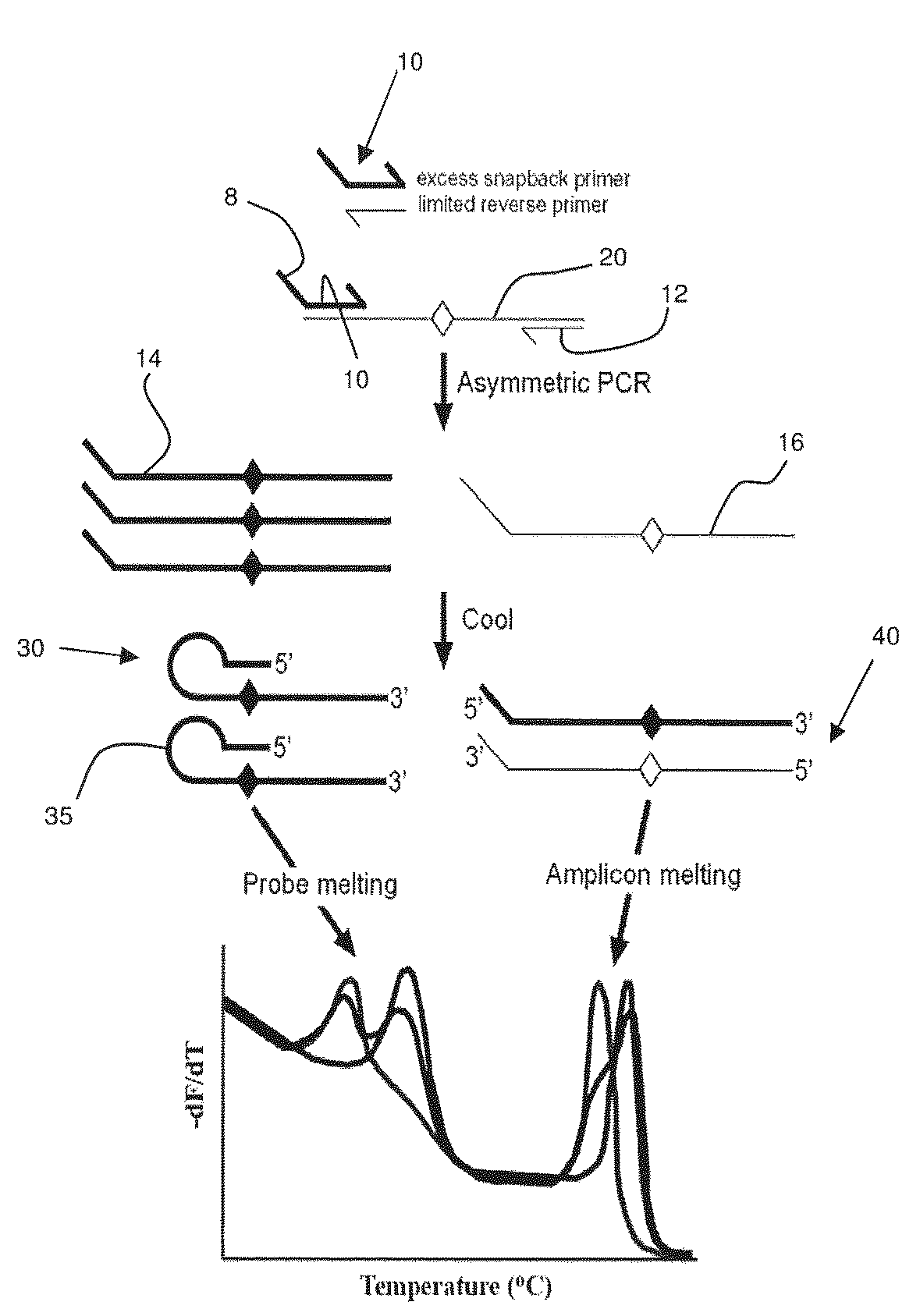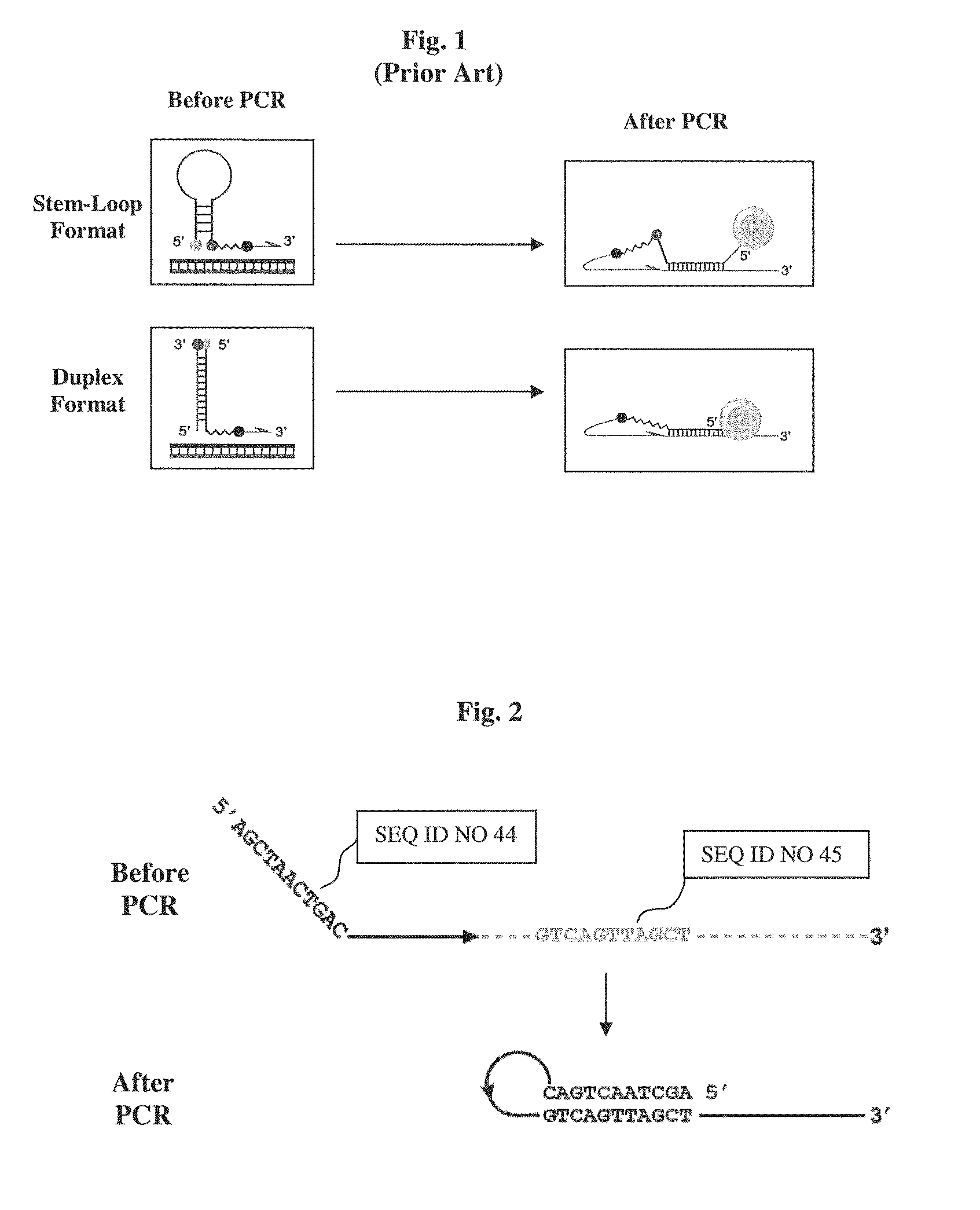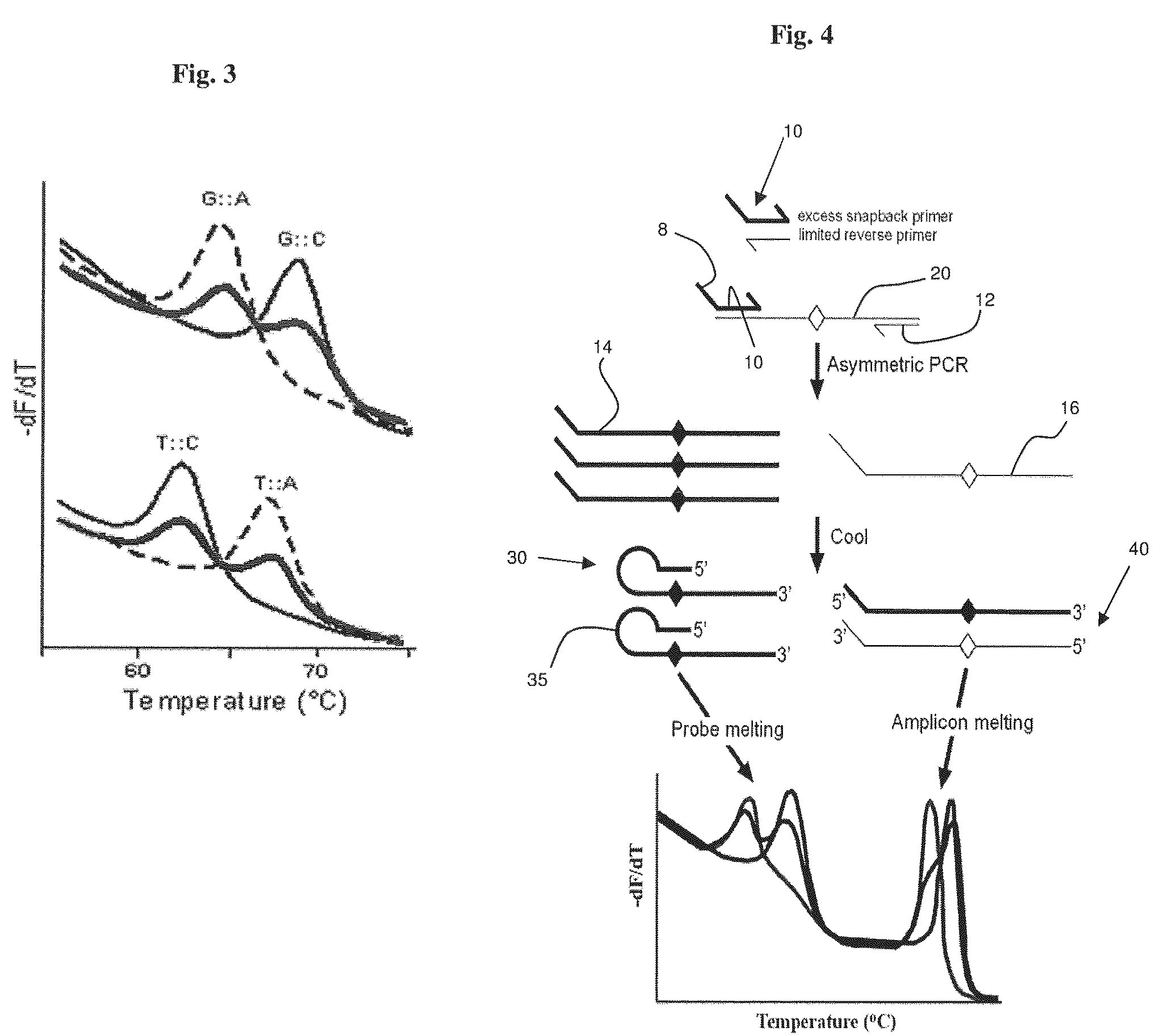Primers for melting analysis
a technology of primers and primers, applied in the field of primers for melting analysis, can solve the problems of difficult routine medical practice using this knowledge, high cost of closed-tube methods, and high cost of fluorescent probes, and achieve the effects of reducing the signal strength of snapback primers that form larger loops, good signals, and high melting temperatures
- Summary
- Abstract
- Description
- Claims
- Application Information
AI Technical Summary
Benefits of technology
Problems solved by technology
Method used
Image
Examples
example 1
Genotyping with a Snapback Primer after Symmetric PCR
[0057]An engineered plasmid template of M13 sequence with 40% GC content was used as template (25). Otherwise identical plasmids with either an A, C, G, or T at one position were available for study. Both the “A” template and the “C” template were studied, as well as a “A / C” heterozygote that was formed by mixing equal amounts of the “A” and “C” templates. The concentration of each plasmid was determined by absorbance at 260 nm (A260), assuming an A260 of 1.0 is 50 μg / mL. The M13 primers used are forward 5′-AATCGTCATAAATATTCATTGAATCCCCtcattctcgttttctgaactg-3′ (SEQ ID NO. 1, with the tail shown in caps and the variable position on the template after the Snapback hairpin is formed shown in bold), and reverse 5′-atgtttagactggatagcgt-3′ (SEQ ID NO. 2), which form a PCR product of about 130 bps.
[0058]PCR was performed in 10-ul reaction volumes with 50 mM Tris (pH 8.3), 500 μg / ml bovine serum albumin, 3 mM MCl2, 200 μM of each deoxynucl...
example 2
Snapback Primer Genotyping with an Extension Blocker Using Symmetric PCR
[0060]To increase Snapback primer loop formation and the height of the Snapback genotyping peaks (low temperature peaks) on derivative plots, an extension blocker was incorporated between the template-specific primer and the probe element of the Snapback primer. Shown as an “X” in the forward primer, the blocker used was an abasic tetrahydrofuran derivative incorporated as the dSpacer CE phosphoramidite available from Glen Research (cat. no. 10-1914-90). Ten contiguous dSpacer units were incorporated in order to ensure blockage of the polymerase. The primers used are forward 5′AATCGTCATAAATATTCATTGAATCCCC(X)10tcattctcgttttctgaactg3′ (SEQ ID NO. 3, with tail shown in caps and variable position on the template after the Snapback hairpin is formed shown in bold), and reverse 5′ atgtttagactggatagcgt3′ (SEQ ID NO. 4).
[0061]Both the “A” template and the “A / C” heterozygote of Example 1 were studied. PCR and melting wer...
example 3
Effect of the Length of the Probe Element on the Signal of Snapback Primers After Asymmetric PCR
[0063]Different probe element lengths were investigated using asymmetric PCR. The M13 primers used are shown in Table 1, wherein upper case indicates the probe element tail, lower case defines the template-specific primer region, and the bold face base indicates the variable position on the template after the Snapback hairpin has formed.
[0064]
TABLE 1NameLimiting Forward Primer (0.05 μM)1Ftcattctcgttttctgaactg (SEQ ID NO: 5)Snapback Reverse Primer (0.5 μM)1R6tailGAATATatgtttagactggatagcgt (SEQ ID NO: 6)1R8tailTGAATATTatgtttagactggatagcgt (SEQ ID NO: 7)1R10tailATGAATATTTatgtttagactggatagcgt (SEQ ID NO: 8)1R12tailAATGAATATTTAatgtttagactggatagcgt (SEQ ID NO: 9)1R14tailCAATGAATATTTATatgtttagactggatagcgt (SEQ ID NO: 10)1R16tailTCAATGAATATTTATGatgtttagactggatagcgt (SEQ ID NO: 11)1R18tailTTCAATGAATATTTATGAatgtttagactggatagcgt (SEQ ID NO: 12)1R20tailATTCAATGAATATTTATGACatgtttagactggatagcgt (SEQ ID...
PUM
| Property | Measurement | Unit |
|---|---|---|
| melting temperatures | aaaaa | aaaaa |
| Tm | aaaaa | aaaaa |
| temperatures | aaaaa | aaaaa |
Abstract
Description
Claims
Application Information
 Login to View More
Login to View More - R&D
- Intellectual Property
- Life Sciences
- Materials
- Tech Scout
- Unparalleled Data Quality
- Higher Quality Content
- 60% Fewer Hallucinations
Browse by: Latest US Patents, China's latest patents, Technical Efficacy Thesaurus, Application Domain, Technology Topic, Popular Technical Reports.
© 2025 PatSnap. All rights reserved.Legal|Privacy policy|Modern Slavery Act Transparency Statement|Sitemap|About US| Contact US: help@patsnap.com



